Green Lantern #1 (DC, $2.99)
by Graig Kent
Though I’ve been less than enthused by Geoff Johns’ reign of silver-age nostalgia that resurrected Barry Allen and Hal Jordan, I would be remiss not to give him credit for what he’s done for the Green Lantern brand over the past five years. The spectrum of different lantern corps was brilliantly orchestrated as was its culmination in the Blackest Night saga, additional to that, what he’s done made Green Lantern a big enough brand to front a big-budget blockbuster movie (a spectacularly crappy movie, mind you, but a summer blockbuster nonetheless). As well, what he’s been doing has been working, well enough that the Green Lantern domain is one of the few “reboot-proof” concepts. Thus, if there’s anything “revised” about Green Lantern between the final issue of the last series, and the start of “The New 52” series, I’m struggling to find it.
The pre-reboot title ended with Hal Jordan being stripped of his ring by the Guardians, and the ring choosing Sinestro as his successor. As much as Johns has been working the past half decade at revitalizing Hal Jordan, he’s been working equally as hard, if not harder at developing Sinestro into, at best, an anti-hero, or at worst a misunderstood villain. I was really hoping that Johns and DC would have the balls to make this new Green Lantern title a straightforward Sinestro-as-GL title, alas the pages featuring a down-on-his-luck, still-a-total-douchebag Hal Jordan outnumber those featuring the title character (Green Lantern isn’t who you are inside, it really is a title).
I wish I could find joy in the schadenfreude of Hal’s situation however Hal just doesn’t seem miserable enough. He’s still too much of a jerk to realize he should be miserable. It’s not that Johns doesn’t write him well, just that he writes him as so self-involved, he’s really not that likeable, and personally, I can’t say I want to see him succeed at becoming a Green Lantern again. Sinestro as the top GL? Now that’s meaty storytelling fodder.
As usual Doug Mahnke, joined by Christian Alamy, draws the hell out of this book. He’s such a vibrant, clean and unique illustrator that I read this book primarily for his work. I love his sense of architecture and design, his zero-G space fighting, and his attention to detail. I’ve been reading his work since illustrating the original Mask comics years ago and my adoration of his work seems to just keep growing.
While Hal Jordan and Green Lantern devotees will assuredly like this first issue as it carries on existing threads while starting a new story, I hesitate to say it’s a good jumping on point for new readers (my stepson saw the cover and I had to give him a 15 minute rundown on why Sinestro isn’t a good guy, but also isn’t a bad guy). Counter to the rest of “The New 52” initiative, it’s still somewhat mired in tons of continuity for any new reader, and I’m not certain new readers coming from the film will be caught up enough. At the very least the book should have had a preface page, a quick synopsis of what’s come before.
Rating: 




Out of a Possible 5 Stars
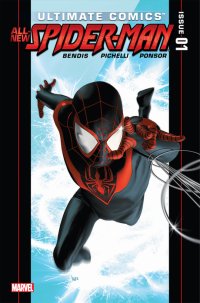 Spider-Man #1 (Ultimate Comics, Marvel, $3.99)
Spider-Man #1 (Ultimate Comics, Marvel, $3.99)
By Jeb D.
As the U.S. gears up for the culture war that will be the election year of 2012, Marvel fires a shot across the tea party bow with the first issue of the new multi-ethnic version of Ultimate Comics’ Spider-Man (as opposed to “Ultimate Spider-Man”). And while it’s kind of a shame that it can’t simply be evaluated on its (considerable) strengths as a comic book, there is a certain amount of sociopolitical baggage that has to be considered.
It’s no secret that Spider-Man has long been a favorite fantasy figure for young non-white superhero fans; of the major flagship characters at either of the Big 2, he’s the rare one whose ethnic background is completely hidden while he’s in costume: Peter Parker may have been white, but Spider-Man could just as easily be Asian, Hispanic, Afro-American, or what have you. That’s the principal reason that the new Spider-Man was both highly controversial, and the right thing to do: making him simply another “legacy” character (in a Phantom-like succession of Flashes, Green Lanterns, etc.; or a “War Machine”-style fillin for a missing hero), or yet another Spider-clone, would always mean that the Spidey of record was Parker, while Miles Morales remained the alternative. By clearing the decks, Marvel and writer Brian Bendis are able to refocus this corner of their Ultimate Universe around a non-white principal character whose costumed exploits can be as “color-blind” as we would wish, while exploring the life and background of a very different sort of young New Yorker who happens to become a superhero.
The storyline (which pre-dates Miles’ cameo appearance in Ultimate Fallout) has most of the basics of your superhero origin story, with a nice callback to the original USM: in a prologue set a year in the past, Norman Osborn wants to find the secret to the spider that bit Peter Parker: something caused it, out of thousands of test animals, to transmit a mutated version of the Super-Soldier formula to Parker, and Osborn plans to replicate and weaponize it. IN the present, young Miles Morales becomes linked to that effort in ways that neither he, or anyone else, suspects, and he gets the requisite spider-bite. And while, as with the first Ultimate Spider-Man series, we don’t get Miles in costume in this first issue (there’s still obviously a ways to go there), we see that the first manifestation of his powers features a characteristic of certain spiders that evidently never occurred to Lee and Ditko, and should prove an interesting differentiation between this Spider-Man and what came before.
As an origin story, it actually somewhat improves on Bendis’ original USM: free to create his own version of a home life for Miles, without being locked into the readers’ expectations of Peter Parker, Bendis brings us a family with some different and unexpected connections: Miles lives in rundown, working-class Brooklyn, not suburban Queens, with his (not at all dead) parents. Miles also has an uncle that will provide some inspiration (and perhaps a form of mentoring), but in ways that are clearly not going to sit well with Miles’ parents.
One thing that hasn’t sat well with some of the comics blogosphere is the fact that the central conflict for the Morales family in this issue is their hopes for beating the odds and getting Miles into a charter school, their hope for a better life for their son. As with the Waiting for Superman documentary that inspired the scene, the entire concept of the charter school is seen by many as Bendis’ assault on teachers’ unions (and, by extension, organized labor in general). Apart from the personal absurdity of that (Bendis has been a member of the WGA longer than some of today’s comic readers have been alive), the fact that the charter school might seem like a ray of hope to the parents of working-class kids of color is perfectly plausible, and the lottery sequence itself is as tensely laid out as any fight scene could have been. And, indeed, all through this issue, Bendis hits his strengths: Tarantino-like scenes of dialog that crackle with as much energy as a superpowered punchup, and deliver necessary exposition and characterization as intriguingly as a good mystery story.
And shame on me for going this long in my review without mentioning the pencils of Sara Pichelli: this woman is phenomenal. It takes most artists years of work to develop the kind of “camera eye” that she demonstrates here, framing scenes in such a way that the reader is pulled along effortlessly, and never letting Bendis’ healthy dose of word balloons get in her way. She is also amazingly gifted at getting “performances” out of her cast, even in silent moments of thought or reaction, with each one getting not only a distinct look, but distinct body language and facial expressions (and it’s particularly impressive because that’s hardly the norm when so much of your cast is African-American men, something that has proven difficult for even veteran comic artists). Details of background, perspective, and even the drape of clothing, are delivered in a manner that feels so natural that you need a second or third reading of the book to realize just how expertly she handles it. And Justin Ponsor’s color palette feels appropriately muted by comparison with the eye-popping color we usually associate with Spidey.
All well and good. But there’s one caveat that I have to offer: there’s a total of 21 pages of actual story here (not counting the credits page and letters page) for your four bucks. I certainly don’t pretend to have an answer to rising costs amid a stagnant economy, but I do know that this model is not sustainable. I’m not actually docking the book in terms of rating for this, but I do think it extremely unlikely that this comic will ever see issue #160, or #100, or anything close to that, if this is the value-for-money equation we’re looking at.
Rating: 




Out of a Possible 5 Stars
Demon Knights #1 (DC, $2.99)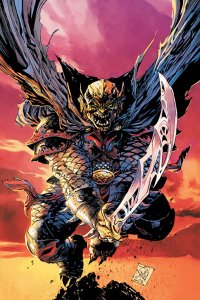
By Adam Prosser
It’s week three of the New 52, and it’s pretty clear to me at this point that the gang at DC are absolutely flying by the seat of their pants. This isn’t a carefully planned relaunch, it’s a “big event” of the kind we’ve gotten so used to over the last few years, hastily thrown together and used to paper over a lot of other things that DC apparently had in the works anyway. This slapdash-ness doesn’t have to be a bad thing—shaking things up can be good for creativity—but it’s got to be a little disorienting for both the fans and the writers whose books aren’t central to the relaunch. We’ve already seen bewilderment over the new continuity as it relates to books like Green Lantern, which are apparently carrying on their merry way with little heed paid to the reboot, whereas a book like Batman, Inc. is left in an unfortunate limbo, and a book like Batgirl gets completely reworked for essentially no reason.
Nevertheless, it’s clear that there is some kind of narrative throughline to the DCnU, and oddly enough, the writer behind it isn’t one of DC’s heavyweights like Grant Morrison or Geoff Johns; it’s Paul Cornell, the generally respected but hardly red-hot Doctor Who writer who’s probably best known among North American superhero fans for the short lived Captain Britain and MI:13 and last year’s Knight and Squire miniseries. In last week’s Stormwatch, Cornell started to lay the groundwork for a new mythology for the DCU (rather brazenly suggesting that Stormwatch are the “real” superhero team in this new continuity, with the Justice League a bunch of Johnny-come-latelies), and indicating that their origins went back to the dark ages. With Demon Knights, we see (apparently) those origins, when a group of DC’s mystical heroes—Etrigan the Demon and his human alter ego Jason Blood, Madame Xanadu, Vandal Savage, and the Seven Soldiers incarnation of Shining Knight—come together in medieval times to confront the menace of The Questing Queen, who’s tromping across the land, exploding babies (seriously: there is an exploding baby in this book).
The story here is pretty basic “getting the team together” stuff, but unlike some of the awkward setups the New 52 have gifted us with so far, Cornell here gives us a clean, compelling introduction to the various characters, with some nicely detailed character snapshots and some refreshingly knotty relationships, particularly the revelation of Xanadu’s relationship to Etrigan, all sketched in efficiently and with snappy pacing. Getting a compelling introduction to a story and its protagonists in a first issue shouldn’t be a lot to ask, but given how rare this quality seems to be at the big two these days (even, or especially, amongst this latest torrent of #1s), I can’t help singling Cornell out for praise.
Rating: 




Out of a Possible 5 Stars
Fr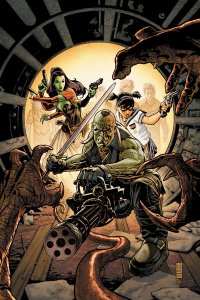 ankenstein: Agent of S.H.A.D.E. #1 (DC, $2.99)
ankenstein: Agent of S.H.A.D.E. #1 (DC, $2.99)
By Adam Prosser
Speaking of Seven Soldiers, another alum of that cult series pops up here as the protagonist of his own book, taking a cue from the recent Flashpoint miniseries (what seems to have been considered something of a highlight of that “event”) and casting him as the leader of a relaunched Creature Commandos. S.H.A.D.E. is back, too, the rather vaguely defined government agency that reunited Frank with his Bride and, as it turns out, his “father” as well, now reincarnated in the body of a Japanese schoolgirl—yes, really.
If that seems rather random, well, that’s this book in a nutshell. I’ve heard great things about writer Jeff Lemire’s more indie-style comics work, like Essex County and Sweeth Tooth but here he strives for a level of Morrisonian weirdness (S.H.A.D.E.’s headquarters is a miniaturized city within a floating sphere known as the Ant Farm, for instance) that doesn’t always click. The Seven Soldiers mini featured a very distinct feel of foreboding and chaos, helped along by purple, gothic narration—rather in the style of the original Mary Shelley novel—by its big green protagonist. It wasn’t without its humour, but it was very deadpan about it, and it committed to the idea of being a horror book. Here, Lemire grounds all his wild ideas in more conventional superheroic goings-on—the bickering, one-liner-spouting relationship between the werewolf and the vampire is already getting old by the end of the first issue—and as a result, some of the dreamlike feel is lost (though Alberto Ponticelli does his part, with thick, scratchy shadows and a detached stylization that helps maintain the creep factor). The other obvious touchstone is Hellboy, with its monster soldiers fighting the forces of evil, but even that series has a more measured, and frankly more confident-feeling, pace to it.
This book, then, is in many ways more conventionally superhero-ish than its obvious influences, right down to its slightly pedantic tone and quippy dialogue. That’s not to say the results aren’t fun at times, and it certainly doesn’t lack for imagination, but it’s hard not to feel like we’re watching a square peg being forced into a round hole.
Rating: 




Out of a Possible 5 Stars
Suicide Squad #1 (DC, $2.99)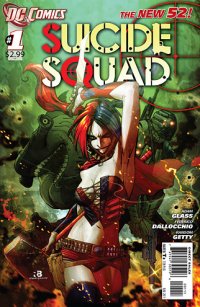
by Graig Kent
The Suicide Squad title that debuted during the mid-1980s DC “reboot” remains one of the best books of its era. There were many ingredients that made it so unique, foremost being its inventiveness, taking a motley cast of (at best) B-grade villains and recruiting them into a secret espionage agency called Task Force X. Another ingredient that made it so great: Amanda Waller, perhaps the best non-costumed character in the entire DCU. A third facet that really worked for that title was a natural take on the world around it. Sure they’re costumed and powered villains, but the missions and personalities involved were quite grounded, less fantastical.
This new Suicide Squad essentially cops to the same basic premise of a group of super-villains enlisted into performing the government’s dirty work (theoretically granting them full deniability) for a chance at a full pardon for their crimes. The crew this time is a who’s who (or rather a “who’s that?”) of super-villainy consisting of an unfortunately tarted-up Harley Quinn, an over-designed Deadshot, a hammerhead King Shark, a drastically different El Diablo, a far more high-tech Black Spider, and some guy named Voltaic, whom I’m guessing is a new creation. Waller is still in charge but instead of being a squat, middle-aged, literal “wall” of a woman, she’s now a busty, sunken cheeked, full-lipped sex bomb (or that’s how she’s drawn in the sole panel she appears in, I suspect they were trying for an Angela Bassett aesthetic). I have no problem with changes, but drastic changes like Harley’s wardrobe and Waller’s appearance better have some rationale to them, something more than just sexy-ing them up.
That said, the new Squad, while devoid of the grounded take that served the 80’s crew so well, still has a nice bite to them. Adam Glass’ first issue begins with the Squad, captured and bound, getting grilled and tortured, their captors looking for them to squeal on their handlers, giving up names and their mission. We’re given flashback’s to the captures of Deadshot, Harley and El Diablo that led to their incarceration while each of them are singled out in torture, as well as a mini-flashback to how they all wound up in their current situation. And it all ends with one hell of a set-up for the next issue which promises to be much, much bigger than this one.
It’s not high-art, but it is quite entertaining. Glass’ script lacks the gallows humour that it’s immediate predecessor, Secret Six, had, but it’s not completely devoid of levity either. In filling the void of Secret Six, it will be interesting to see if Glass can build a team like Gail Simone did, and if he’s even interested in building a support organization like the 80’s Squad had. The foundation Glass has laid so far is really good, but what it really needs is consistency on art. Two different artist handle the duties on this issue’s 20 pages, each distinct enough from the other to be noticeable and a little distracting.
Rating: 




Out of a Possible 5 Stars
Buffy The Vampire Slayer Season 9 #1
Angel and Faith #1 (Dark Horse, $2.99)
by Graig Kent
 I’m not a Buffy devotee or a Whedonite or whatever the fanatics call themselves. I’m a casual fan who stopped reading Buffy Season 8 around the point where she went all lesbian, and it wasn’t any moral objection or even any staunch protest against the direction they were taking the book or character. It was, at the time a matter of economics. I was reading a lot of titles, some had to go.
I’m not a Buffy devotee or a Whedonite or whatever the fanatics call themselves. I’m a casual fan who stopped reading Buffy Season 8 around the point where she went all lesbian, and it wasn’t any moral objection or even any staunch protest against the direction they were taking the book or character. It was, at the time a matter of economics. I was reading a lot of titles, some had to go.
I seem to recall at the time I started reading Season 8 of Buffy before I had even watched Season 7. Well, tradition continues, as I’m only about halfway through Season 8 (after a long hiatus I’ve decided to catch up this week) and now I’m starting Season 9. I had much of Buffy and Angel pre-spoiled for me before I came to them on DVD (a hazard of coming to things so long after their initial run), so again, tradition continues because both Angel & Faith #1 and Buffy The Vampire Slayer Season 9 #1 are chock-a-block with spoilers about the end of Season 8.
Season 9 opens with Buffy having a house party. Without getting all spoiler-y (to use the vernacular of the issue) Buffy is no longer queen of the slayers and is now living in San Francisco trying to have as normal a life a demon killer can have. Her party goes great, her roommates dig her and, by all appearances her friends (Xander, Willow, Spike) are still her friends and have followed her to her new hometown. Season 8 went big-big-big because it was free of the constraints of effects budgeting, which many fans railed against, Season 9 intentionally goes small, microscopic, focused almost exclusively on Buffy and the minutia of her mundanity. It’s a cute start, but personally I liked the big-ness of Season 8 so this seems almost too drastic a reversion.
Joss Whedon scripts an exceptionally light “episode” of Buffy (with a darker, repressed undercurrent) and Georges Jeanty does his usual remarkable job returning as series illustrator, although his new inker Dexter Vines adds a heavier lines than Jeanty’s work from last season which at once adds more definition but at the same time impacts facial expressions giving the core characters a bit more severe an appearance at times. I imagine Buffy fans will love this new start, even the lapsed ones, though it was a little too action-free for my taste, which may make it a harder sell for the casual fan. Perhaps once I polish off Season 8 it may take on a different weight.
Angel & Faith #1 isn’t a new “season” of Angel so much as an extension of Buffy Season 9, which is somewhat 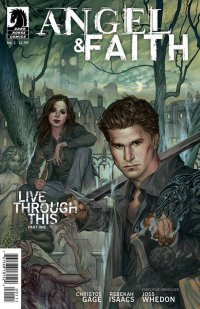 disappointing since I’ve been quite curious about what happened after the rather dramatic series finale in which LA went straight to hell. I know IDW had the comics rights to Spike and Angel for years and did an unofficial “Season 6” but the art on those books were so awful that I couldn’t bring myself to read them. I was excited to see Dark Horse pick up the license, and my interest most definitely piqued by the combination of Faith and Angel in their own series.
disappointing since I’ve been quite curious about what happened after the rather dramatic series finale in which LA went straight to hell. I know IDW had the comics rights to Spike and Angel for years and did an unofficial “Season 6” but the art on those books were so awful that I couldn’t bring myself to read them. I was excited to see Dark Horse pick up the license, and my interest most definitely piqued by the combination of Faith and Angel in their own series.
This one is far more action heavy, and equally more overtly dramatic than Buffy Season 9 #1. Whereas Buffy and the Scoobies do all their brooding under a mask of humor and joviality, Angel wears his brooding proudly on his black leather trenched sleeves. As he’s responsible once more for the death of a comrade, Faith is there to see him through the dark times, and, perhaps to ensure that there’s no residual nastiness residing in her friend. As well, Faith is keeping an eye on many of Buffy’s former acolytes, some of whom are organizing to take on Angel for his part in whatever nastiness it was that happened in Season 8.
Written by Christos Gage, this first issue of Angel & Faith is far less about subtext than Buffy, putting all the the emotions and pain face front, as well as establishing the obstacles-to-come more bluntly. This isn’t at all a negative since Gage deals with them masterfully. He has a good ear for the Whedon-style without getting too cute or wordy about it. He’s joined by illustrator Rebeckah Isaacs who is a beautiful match for Jeanty over on Buffy. Through she doesn’t quite capture likenesses in the same way Jeanty strives for, she adheres to a specific design for the characters and has a good sense of body language and facial expressions, which are key to stories in a Whedon-created series.
While I do like what Gage has set up here, I’m hoping that this first Angel series from Dark Horse also fills in the gaps from the end of Season 5 as well, with a little Gunn here, Illyria there, and some Spike, because the Angel/Spike combo is gold.
In any case, if what usually holds true with Buffy and Angel as TV shows, even if individual episode are weak, they usually combine to make a satisfying whole.
Buffy The Vampire Slayer Season 9 #1 -Rating:
Out of a Possible 5 Stars
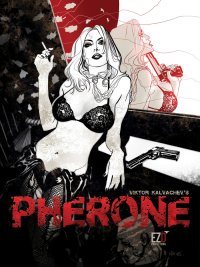 Pherone TPB (EZD Productions/Image, $14,99)
Pherone TPB (EZD Productions/Image, $14,99)By Jeb D.
The deadly seductress with a sideline in ass-kicking and bloody mayhem isn’t exactly a dime a dozen in popular culture, but there’s enough of them about that presenting yet another iteration sort of mandates that you come up with a new angle… which, of course, is easier said than done.
Pherone began its existence as a “side project” for video game/comic artist Viktor Kalvachev. With the help of writers Patrick Baggatta and, later, Jim Sink, the comic was serialized in Heavy Metal magazine, and is here collected for the first time.
When we first meet Eve, she’s involved in a formulaic, but nasty, bit of wet work involving a mobster who she’s seducing into letting his guard down. Things develop as you might expect (hint: there’s blood aplenty, and it’s not Eve’s), but Baggatta quietly tosses in a few hints that things aren’t precisely as they seem. Exactly who Eve is, and how she got into the business of brutally offing dangerous men, is revealed at a nice pace over the eighty or so pages of story here; the reveals aren’t exactly startling, but they keep the reader guessing enough that we’re invested in learning more. Most of the story’s characters are more functional than anything else (mysterious operatives that know more than Eve does, cold-blooded scientists, cops on the trail of her killings, etc.), though Eve’s best friend (and perhaps more than that?), Cass, is given a reasonably well-rounded presentation, despite her cliché old-school lesbian look. Baggatta and Sink keep the dialog mostly functional, as well, but they also do a good job of not over-writing the necessary exposition.
Despite being assembled from work done over a few years, the storytelling manages to avoid choppiness, for the most part. The art has a somewhat Sin City look to it, with dangerous splashes of color over lots of stark white and inky black; a few flashback sequences are presented in a softer, full-colored style, its purplish tone reminding us of its origins in Heavy Metal. Kalvachev’s paneling is effective, and the action scenes are mostly well-presented. Stylistically, he leans toward the sort of chiseled shadowing and facial lines that can give a sort of plastic-on-metal look to the characters (who sometimes wind up resembling the cast of Will Smith’s I, Robot); it’s not particularly to my taste, but enough other artists are employing a similar style these days that it’s evidently more appealing to some readers. There is also a 10-page “pilot” episode included, that doesn’t relate to the main storyline at all, but served to get the concept off the ground, and works as a standalone story.
Pherone isn’t ground-breaking, but its 90 pages of story, plus the generous (if obligatory) “bonus” of deleted scenes and concept art, is enough to justify the fifteen bucks. If you’re in need of a fresh infusion of bloody-handed femme fatale, it’s the book for you.
Rating: 




Out of a Possible 5 Stars
Resurrection Man #1 (DC, $2.99)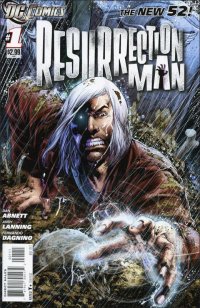
by Graig Kent
One of my favorite series of the late ’90’s was the 28-issue series Resurrection Man, about Mitch Shelley who discovered that not only couldn’t he die, but each time he died he would come back to life with a different super power. It’s been some time since I revisited the series, so I can’t tell you specifics on what it was that attracted me, rather just vague recollections. I recall liking the series based on the concept alone, but also that series writers Dan Abnett and Andy Lanning built a great character within a title riddled with mysteries. It was also illustrated by Butch Guice who style seemed perfectly suited to the often grim tone of the book. I lamented its loss for a short time, and moved on, as did Abnett and Lanning to consistently solid work (as of late, show running the Marve Cosmic line), as Butch Guice has as well (doling out some incredible work recently on Captain America).
Well, I’m going to say it, the series has been resurrected, with Abnett and Lanning back on their creation. For new readers it’s a solid introduction, and for old readers and equally solid reintroduction to Mitch Shelley’s world and abilities. It’s a fast-paced book, resurrecting Mitch not just once, but twice within its pages. It introduces a lot, including the new twist that upon each resurrection Mitch is drawn to an area to fulfill a specific purpose (adding a Quantum Leap element to it). There’s also the Body Doubles, a pair of ruthless assassins that look like porn stars (holdovers from the old series), who are hot on Mitch’s tail for some reason, as well as an organization of inhumans that seems to be keen on collecting Mitch’s well-past-due soul. It’s all quite interesting, if a little too compressed (for all the grumbling about comics being too decompressed, that’s a rare complaint), like it’s a two-hour TV pilot cut down to 44 minutes. There’s a terrific sequence that takes place on a plane, then moves outside the plane and ultimately results in the plane crashing, however since Mitch is generally our POV man, and he’s not so alive when the plane goes down, we’re kind of robbed of the Lost-like spectacle, though the aftermath is well-handled.
Abnett and Lanning are joined by Fernando Dagnino, whose style isn’t quite the same as Butch Guice’s but isn’t all that different either. He’s more on the side of Gene Colan giving the book a bit more of an old-school horror vibe, though it’s a really soft horror that’s largely more comfortable in action/suspense/thriller mode. Dagnino’s style is as much about mood and setting as it is about movement, character and action, which leads to some wonderful visuals of the plane in the sky on a stormy night and of the post-crash burning wreckage in the woods. The story is good but it’s really the visual atmosphere that sells it. Looking forward to more.
Rating: 




Out of a Possible 5 Stars
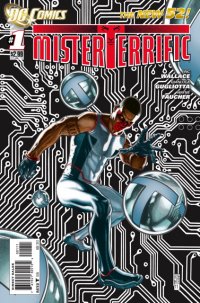 Mister Terrific (DC, $2.99)
Mister Terrific (DC, $2.99)
by Graig Kent
Though he’s been around for almost two decade Mister Terrific remains one of those characters who has been sidelined for years, gaining the attention of fans as a solid supporting player yet has remained rather mysterious and criminally underdeveloped. With “The New 52” the world’s third smartest man is granted the opportunity of his own title to showcase his potential.
What the new series does is display how commanding Michael Holt, aka Mister Terrific is as a character. Regardless of the quality of the book, there is never a moment where you doubt that he should have his own title. That said, the book is a hot mess, an overloaded script marred by weak illustrating. Writer Eric Wallace seems to enjoy writing peripheral dialogue, conversations that happen outside of the main action, typically as a source of levity, but if these conversations are supposed to be humorous they lack panache. At the same time I’m certain much of the flatness of the humour has to do with delivery through Gianluca Gugliotta’s muddy illustration. Gugliotta puts Mister Terrific in powerful poses, but fails to capture the nuances of facial expressions which the script absolutely demands. As well, the illustrator has difficulty with civilian attire, and moreso upscale attire, which here are bland and unappealing, and that is quite a problem when much of the book takes place in civvies.
Wallace has given this super-smart, billionaire superhero a ninth-dimensional batcave, the T-Sanctuary, which is a pretty cool new hangout, a bit of the old super-science injected into comics anew, but it’s again marred by a lack of visual flair form Gugliotta. In the two-page spread it looks like a vague impression of the inside of the Tardis, but under-populated with anything interesting to look at.
Wallace introduces a supporting cast by way of Karen Starr (sans any allusion to her being Power Girl), a smart teenager named Jamaal (whom I assume Michael is mentoring although the script is exceptionally vague about their relationship) and a woman whom I assume is Jamaal’s mother (again, the script is vague), although she and Karen are set up as rivals for Michael’s romantic affection. These ill-defined relationships between ill-defined characters are obviously problematic as a reader.
The sequencing of the book is challenged too, with Wallace introducing a mystery that makes it’s way to the fore by the end, as well as a quick bit of back-story on Michael’s loss of his wife and unborn son, followed immediately by the mysterious appearance of a time hopping teenager who claims to be his son. With an opening superhero adventure, and the social soiree, it really is too much at once, and though comics used to read like this all the time 30 years ago, storytelling is expected to be a little less on the nose. I can predict, given the massive dump of a set up this first issue that subsequent issues may move along more smoothly, at least that’s my hope. The character deserves a shot at a quality series, and so far the cover (by J. G. Jones) is the only thing living up to it.
Rating: 




Out of a Possible 5 Stars